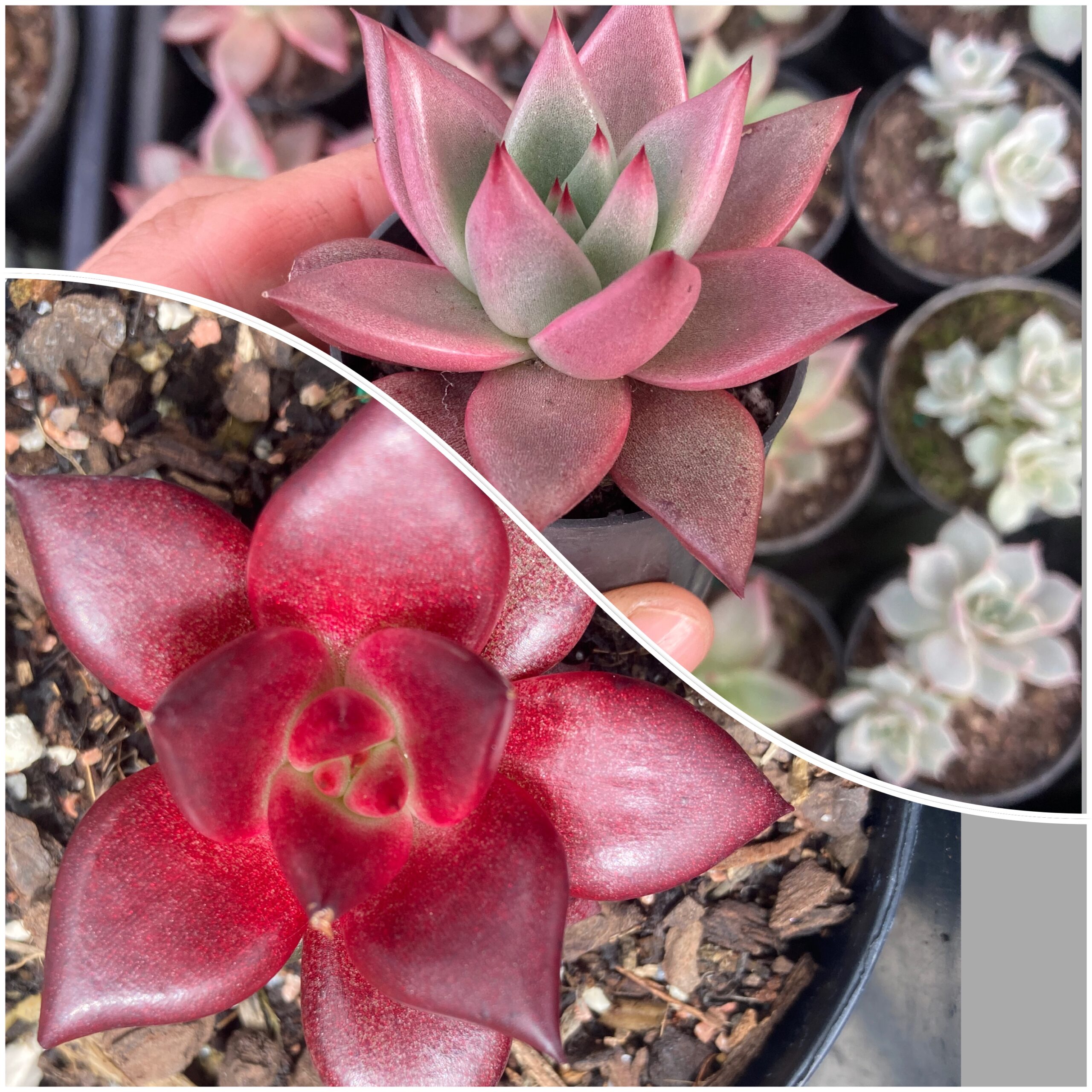Your cart is currently empty!

Echeveria Romeo vs Rubin
Echeveria Romeo and Romeo ‘Rubin’ are closely related in the plant world but in many ways, they could not be more different. Rubin is a mutation of Romeo that not only differs in colour but also in its resilience. I grow both of these plants at our nursery and have over the years observed and learned all the dissimilarities.
Echeveria Romeo vs Rubin- Colour
Echeveria Romeo is shades of pink with blood red tips and edges when the plant is stressed. Most often in winter the pink intensifies into its darker palettes During the warmer months a bit of green can come through from the centre of the rosette.
Rubin is deep wine red when the colour fully comes through in winter and early spring. For the rest of the year when the weather is warm, Rubin will also lose some of its red and change to light green from the centre.
Echeveria Romeo vs Rubin- Leaf Shape
Both Romeo and Rubin are quite similar in the way their leaves grow and arrange. Being Agavoides cultivars, the leaves are pointy and glossy. For both plants, the leaves are quite thick as well, and more light they receive, thicker and more compact the overall shape will become.
The shape can differ slightly across plants from different growers, especially with Rubin. This can be put down to the particular plants used to make tissue culture.
As an example, we got several different batches of tissue culture Rubin from various horticultural labs and the leaves can either be narrow and longish or short and stubby. The difference is not very significant, but it can sometimes look as if there are two types of Rubin.
Echeveria Romeo vs Rubin- Size
Echeveria Romeo and Echeveria Rubin can grow to approximately 10-15cm height and width. Plants grown in shade may stretch their leaves a little more and, as a result become, slightly bigger across but shorter.
Echeveria Romeo vs Rubin- Hardiness
This is what I find most astounding. Echeveria Rubin is much more hardy than Echeveria Romeo. All our Rubins are grown in the outdoor part of the nursery, all year round. They can deal with heavy rain, humidity & heat (although we do have shade-cloth over for the hot months as it often gets very hot).
Romeo, however, struggles with all of that and grows in a plastic igloo. If Romeo was exposed to lots of rain and same conditions as our Rubins, it would either rot, develop ugly black fungus marks or split leaves. Romeo is a bit of a drama queen and a difficult plant to keep looking spotless.
Echeveria Romeo vs Rubin- Propagation
There is no good news here- both Romeo and Rubin are very hard plants to propagate. They rarely produce offsets and mostly grow as solitary rosettes.
It is possible to grow them from leaves, but it is incredibly hard and the strike rate very low. We have and article on how to propagate Rubin from leaves, though the conclusion is that it may be best not to try as a plant can easily be destroyed and there’s a good chance the leaves will not produce any new growth.
Echeveria Romeo vs Rubin- Price
The price can be quite high, though Rubin tends to be the more expensive plant these days. This is probably due to its highly prized bright red colour as not many succulents are permanently red.
Both are also pricey because they are incredibly hard to propagate and growers find it hard to source tissue culture plants of Romeo and Rubin.
Our nursery Fern Farm Plants sells Echeveria Romeo and Echeveria Rubin, though they are often out of stock due to their popularity.
You may also want to read up on Echeveria Romeo and Echeveria Rubin in more detail. Clicking the names will take you to an in-depth article detailing how to grow, propagate and care for these wonderful succulents.